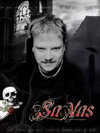
Having been beaten to the shelves by the Real Air Simulations Spitfire XIV, the Just Flight package has a lot to live up to, although in fairness they have covered a lot more of the Spitfire's history. Lets have a look at what we've got in the box.
The add-on comes on two CD-ROMs, and includes a comprehensive manual, which is styled as, and includes, abridged pilot's notes covering the Spitfire. This is of the usual good quality from Just Flight. There is also an interactive program covering flying the Spitfire. As far as the aircraft are concerned, we have 39 models, depicting the following marks (a full list of the specific airframes included is available on the Just Flight website):
*denotes CFS3 enabled, ** denotes CFS2/CFS3 enabled
Prototype K5054
Mk. I, Mk. Ia* & Mk. Ib*
Mk. IIa
Mk. Vc*
Mk. Vb**
Mk. IX, IXE & T. IX
Mk. XIVE*
Mk. XIX
Mk. XXII

Spitfire PR Mk XIX in Swedish colours
So, we have a rounded selection of aeroplanes, which I was thoroughly looking forward to getting my hands on. However, before I do that, I'll put down my cup of tea, put on the flying jacket and saunter over to the dispersal to have a closer look at these beauties on the ground...
Visually, the modelling is of a generally very good standard. The Spitfire is an aircraft well known for its flowing curves, and is notoriously difficult to model well. The one area where this package may have been let down is the vertical fin and rudder, which on certain marks (XIV and XXII) does not look quite right. The early marks (Prototype and early Mk 1s) come with a beautifully crafted two bladed wooden propeller, the later ones with variable pitch props with up to five blades. The movement of the blade pitch is modelled statically, and it is a nice touch to see it moving as you conduct you pre-start checks. The other animations are fairly standard (Opening canopy, door, radio access panel).

Spitfire Mk IX in the marking of one of the "Free French" Squadrons
The markings on the aircraft are generally fairly accurate, and are from several countries, including a Free French Mk IX, Belgian Mk XIV and Swedish PR Mk XIX. Some of the colours are slightly wrong on some particular aircraft (duck egg blue undersides on several aircraft that should be light grey), but you would have to be very familiar with real aircraft to notice, and it detracts very little from the package. The textures are nowhere near as fine as those found on the Real Air Simulations Spitfire (which are exceptional), but there is a lot more variation in the types of scheme, be it the light blue of the prototype (the best quality textures in the package), the yellow civilian T. IX trainer, or the natural metal finishes of the Mk XIV and XXII.

Early Mk 1 Spitfire
The 2D panel is very good, as should be expected now that we are in the age of the virtual cockpit. The virtual cockpit itself has the relevant controls animated, to allow manual functions such as engine start to be performed from it, and is different for each of the individual marks.

Spitfire PR Mk XIX 2D Panel

Spitfire Mk 1 Virtual Cockpit








